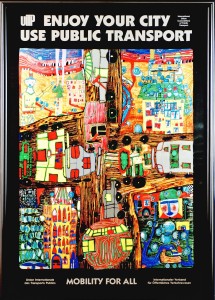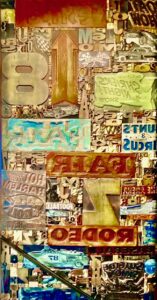The History of Collage Art

“Enjoy Your City – Use Public Transport – Mobility For All” Poster by Friedensreich Hundertwasser
Paintings and sculptures have been the main art forms that define Fine art for many centuries, but over the past century, other forms have also risen to prominence. Collage, which involves the gluing of different papers or mixed materials to a background surface, is also a Fine art form in its own right. How did it come to be? Here is a brief history of collage art.
Picasso and Braque
In September 1912, Georges Braque, a Cubist artist in France, visited a wallpaper store and found some wood-patterned wallpaper. In his studio, he pieced together his first collage (papier collé, or glued paper) and showed it to his close friend, Pablo Picasso. Picasso at once embarked on a prolific collage series, and these groundbreaking works of Picasso and Braque spread its influence throughout Europe. Their works incorporated snippets of patterns, drawings, prints of newspapers and pop sheet music, etc.
Post World War I
After World War I, the world fell into disillusion, illustrated aptly by the artists of the time. Collage was one method that artists used to create art in the Dada and Surrealist styles. Most notable was an exhibition held at Galerie Goemans by Louis Aragon exclusively for collage art. It featured many of the famous 20th-century artists alive in 1930, including Joan Miró, Marcel Duchamp, Man Ray, Salvador Dali, Picasso, and Braque. A couple of artists, including Man Ray, were included because their paintings used the collage principle.

Wall Collage of Globe Poster Letterpress Printer’s Cuts by Phyllis Zimmerman
World War II
During World War II, Peggy Guggenheim was able to open the Art of This Century gallery in New York City. At this landmark gallery, Guggenheim displayed the works of the most famous avant-garde artists who used collage, such as Marcel Duchamp, Joseph Cornell, Laurence Vail, and more. She also held an “Exhibition of Collage” that featured American artists such as Jackson Pollock, William Baziotes, and Robert Motherwell. Every Surrealist and Modern artist gave a unique contribution to the development of collage.
Post World War II
Collage only began to reach the artists of California after World War II. With little influence from Europe, it was free to develop in its own direction, making use of mixed materials such as scrap metal. In the following decades after the Second World War, collage found itself mixed in Beat and Pop art.
Collage Art Today
Collage continues today to be a method of creating Fine art around the world. Looking back at history, one can see that the body of collage works informs the viewer of the passage of history and culture in the last century. Today, it continues to be a subject of fascination for artists and collectors alike.
Contact Zimmerman Fine Art Today!
Since 1979 Zimmerman Editions Ltd. has worked closely with many internationally acclaimed artists to execute editions of their most unique images. Collaborating directly with the artists, Zimmerman Editions’ atelier has printed, fabricated, and published many special limited editions of fine art, including both prints and sculptures. All images have been faithfully produced to meet the artists’ most exacting requirements. Many of these high-quality art prints and objets d’art are represented in public and private collections around the world.
If you are a fine art dealer or marketer, or interested in collecting contemporary fine art, contact us today through our short form or our number at 888-484-1850. For more about fine art, keep in touch through Facebook, Twitter, and LinkedIn!
